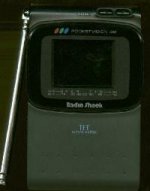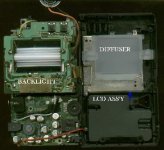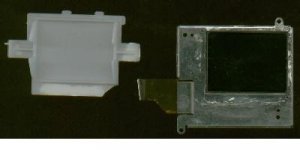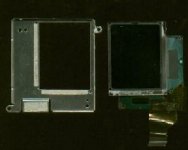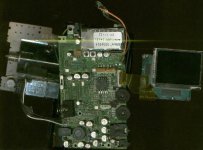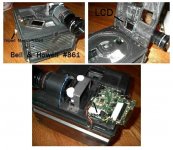Sounds like some fun stuff to try out!
3 bit level. 3 pads, hence 3 bits, right? For each one?
So, you're not modulating them but flashing them at variable rates of intensity via the code you push in there. The timing done by the real time analog to digital conversion of the input signal. ??? And, the panel itself is merely turning on and off the pixels that pass reflection?
Have you got an idea about setting this up with larger/more intense lights? Not too complex, I imagine. Just 3 variable RGB sources you can control. Composite/RGB analog signal to a digital voltage/current controller of each light. Bathe the lcd in that at 45 degrees and the reflection into a focussing mechanism. Maybe??
I want to try that! Where are you?!
3 bit level. 3 pads, hence 3 bits, right? For each one?
So, you're not modulating them but flashing them at variable rates of intensity via the code you push in there. The timing done by the real time analog to digital conversion of the input signal. ??? And, the panel itself is merely turning on and off the pixels that pass reflection?
Have you got an idea about setting this up with larger/more intense lights? Not too complex, I imagine. Just 3 variable RGB sources you can control. Composite/RGB analog signal to a digital voltage/current controller of each light. Bathe the lcd in that at 45 degrees and the reflection into a focussing mechanism. Maybe??
I want to try that! Where are you?!
lokost
...Or, is the reflective panel using a similiar delta (RGB) pattern? And if so, then it simply adjusts the transmission of the reflected light of each of these pixels anywhere from on and off? Am I anywhere close? And then the lights are just controlled intensity-wise?
errrr... Does the pixel reflect the light or does it bounce off a mirrored surface just behind the pixel and then bouncing back out through the pixel???
???
...Or, is the reflective panel using a similiar delta (RGB) pattern? And if so, then it simply adjusts the transmission of the reflected light of each of these pixels anywhere from on and off? Am I anywhere close? And then the lights are just controlled intensity-wise?
errrr... Does the pixel reflect the light or does it bounce off a mirrored surface just behind the pixel and then bouncing back out through the pixel???
???
SushiMasterX
I always drool when I read the specs on the microdisplay. It is a register-laden cutty pie. I think you are pretty close. Here is how it works:
Video modulation:
Pixel brightness depends on how long a pixel is turned on during "pixel time" which has a max 8-bit duration. Each pixel sequentially reflects the 3 LED colors.
End user brightness:
A corresponding color LED is turned on during the pixel time. The 3 LEDs are turned on in sequence. Remember if the pixel is off there is no reflection. The color balance can be a one time set up; you write an 8-bit value into each LED's current register.
I am holed up in Central Texas. Might interest you to know this thing is also used in the JVC dImage video camera.
My plans:
1. Do exactly as you suggested with beaucoup LEDs using the built-in test pattern.
2. Figure out the video end of things if step #1 looks promising.
3. Make an N x M matrix display with external mirrors to achieve the best resolution I can afford. This will be along the lines of a homemade DMD type system.
I always drool when I read the specs on the microdisplay. It is a register-laden cutty pie. I think you are pretty close. Here is how it works:
Video modulation:
Pixel brightness depends on how long a pixel is turned on during "pixel time" which has a max 8-bit duration. Each pixel sequentially reflects the 3 LED colors.
End user brightness:
A corresponding color LED is turned on during the pixel time. The 3 LEDs are turned on in sequence. Remember if the pixel is off there is no reflection. The color balance can be a one time set up; you write an 8-bit value into each LED's current register.
I am holed up in Central Texas. Might interest you to know this thing is also used in the JVC dImage video camera.
My plans:
1. Do exactly as you suggested with beaucoup LEDs using the built-in test pattern.
2. Figure out the video end of things if step #1 looks promising.
3. Make an N x M matrix display with external mirrors to achieve the best resolution I can afford. This will be along the lines of a homemade DMD type system.
lokost,
That sounds like a cool design. How does Samsung do it? What type light, other than LED, could be "flashed" at a frequency suitable for this purpose?
Edit:
Ah, I just thought of a solution that is used for DLPs...a color wheel! That could open up some lighting possibilities. That is, if I am even understanding the FLCD concept correctly 😱 !
-f4
That sounds like a cool design. How does Samsung do it? What type light, other than LED, could be "flashed" at a frequency suitable for this purpose?
Edit:
Ah, I just thought of a solution that is used for DLPs...a color wheel! That could open up some lighting possibilities. That is, if I am even understanding the FLCD concept correctly 😱 !
-f4
fender4,
You just described Samsung's design. I remember reading somewhere that they were using a much lower power and lumens source compared with normal projectors; that's why I'm so confused about the bit on reflective lcds requiring more light than the transmissive lcds.
You just described Samsung's design. I remember reading somewhere that they were using a much lower power and lumens source compared with normal projectors; that's why I'm so confused about the bit on reflective lcds requiring more light than the transmissive lcds.
I'm not so sure that they do require more light.
After a brief glance at the spec sheets on Displaytech page, I think the actual pix design is pretty novel...not just an LCD with a reflective backing. Now THAT would require more light...2X as much as a transmissive design.
Months ago in the "other thread", someone mentioned placing a first-surface (front-surface) mirror at the back of an LCD to make it reflective. The problems are that it would take 2X as much light for the same brightness (two passes through the LCD), and there would be distortion because of the slightly different paths of the entering and exiting light rays (because the light source would need to be off-axis). It doesn't seem that the FLCD panels suffer from these problems.....
I think we are dealing with a different animal here!
The color wheel shouldn't be that tough to figure out. Here's a link:
http://www.sciplus.com/singleItem.cfm?terms=996
Notice the quote in the description: It was made to be spun at 4560 rpm as part of a “field sequential display system” whatever that is. Sound familiar? 😎
I gotta get back to the books. Good luck, everybody.
-f4
After a brief glance at the spec sheets on Displaytech page, I think the actual pix design is pretty novel...not just an LCD with a reflective backing. Now THAT would require more light...2X as much as a transmissive design.
Months ago in the "other thread", someone mentioned placing a first-surface (front-surface) mirror at the back of an LCD to make it reflective. The problems are that it would take 2X as much light for the same brightness (two passes through the LCD), and there would be distortion because of the slightly different paths of the entering and exiting light rays (because the light source would need to be off-axis). It doesn't seem that the FLCD panels suffer from these problems.....
I think we are dealing with a different animal here!
The color wheel shouldn't be that tough to figure out. Here's a link:
http://www.sciplus.com/singleItem.cfm?terms=996
Notice the quote in the description: It was made to be spun at 4560 rpm as part of a “field sequential display system” whatever that is. Sound familiar? 😎
I gotta get back to the books. Good luck, everybody.
-f4
Hey SushiMaster!
I've been going crazy with work (appropriately enough, I work at a TV station) but I've got one of the engineers hooked on the DIY projector idea. Te best part is I can have access to the engineering shop with all of the wonderful equipment! So I am going try two things...
1. To get the TV working in the slide projector and making a big image.
2. Look around in the professional supply catalogs for some parts to construct a better, even smaller version of the projrctor...sans carousel...
Excellent research on the Casio, by the way! It's a cheap way to try this project out.
I've been going crazy with work (appropriately enough, I work at a TV station) but I've got one of the engineers hooked on the DIY projector idea. Te best part is I can have access to the engineering shop with all of the wonderful equipment! So I am going try two things...
1. To get the TV working in the slide projector and making a big image.
2. Look around in the professional supply catalogs for some parts to construct a better, even smaller version of the projrctor...sans carousel...
Excellent research on the Casio, by the way! It's a cheap way to try this project out.
Pics of Mini-TV LCD Disassembled:
Fender, Lokost: Thank you for the description of the Displaytech panel. I am still a little confused how it works and wish I had a "pop-up" book with pictures, ha-ha! I will have to sit down and read their tech sheets to fully understand.....and then with the color wheel you will only need one light source! Those are definitely for video production!
Still waiting for reply back from some of the resellers of the Unipac hi-res panel. All say they is "not in stock" and will have to call me back. Probably, contact their Taiwan office and find out they aren't there anymore. Just have to wait.
Glasstron panels are looking like my next resource of hi-res. Anyone know if the 700 model is transmissive or reflective? I prefer transmissive still, at this point. The I-visor is a reflective panel with the same res as the 700 (800xRGBx600). Couldn't find anything at Sony on that one. Page it refers for tech info, is not there.
Manny:
Here are the pics of the disassembled tv I first used. The panel's fried. Nonetheless, you can sorta see what you're getting into. If you haven't already. Not much to it, really. Just be careful.
This one had to be mounted on a non-conventional slide projector because of the ribbon cable being too short and connected along the vertical side. Hopefully, yours won't be like that!
Be careful, as you have all that bare conducting metal there. I put some duct tape across the whole surface of the circuit board (both sides) and anything that might be exposed to anything.
The display light may be detached on some models without problems. But, I seem to recall this one not driving the lcd, if it didn't have the light connected. Some sorta safety perhaps? I don't exactly recall. It was over 8 years ago. Anyway, you can reattach it.
Ideally, you can get it outta there to clear up some of the clutter.
If you have an overhead at your office you can power up and put the panel on there for a quick view of what you have, picture-wise.
Pics of the Radio Shack PocketVision32 #16-169 (Ebay may have these sometime):
Fender, Lokost: Thank you for the description of the Displaytech panel. I am still a little confused how it works and wish I had a "pop-up" book with pictures, ha-ha! I will have to sit down and read their tech sheets to fully understand.....and then with the color wheel you will only need one light source! Those are definitely for video production!
Still waiting for reply back from some of the resellers of the Unipac hi-res panel. All say they is "not in stock" and will have to call me back. Probably, contact their Taiwan office and find out they aren't there anymore. Just have to wait.
Glasstron panels are looking like my next resource of hi-res. Anyone know if the 700 model is transmissive or reflective? I prefer transmissive still, at this point. The I-visor is a reflective panel with the same res as the 700 (800xRGBx600). Couldn't find anything at Sony on that one. Page it refers for tech info, is not there.
Manny:
Here are the pics of the disassembled tv I first used. The panel's fried. Nonetheless, you can sorta see what you're getting into. If you haven't already. Not much to it, really. Just be careful.
This one had to be mounted on a non-conventional slide projector because of the ribbon cable being too short and connected along the vertical side. Hopefully, yours won't be like that!
Be careful, as you have all that bare conducting metal there. I put some duct tape across the whole surface of the circuit board (both sides) and anything that might be exposed to anything.
The display light may be detached on some models without problems. But, I seem to recall this one not driving the lcd, if it didn't have the light connected. Some sorta safety perhaps? I don't exactly recall. It was over 8 years ago. Anyway, you can reattach it.
Ideally, you can get it outta there to clear up some of the clutter.
If you have an overhead at your office you can power up and put the panel on there for a quick view of what you have, picture-wise.
Pics of the Radio Shack PocketVision32 #16-169 (Ebay may have these sometime):
Attachments
The SushiMasterX "GinsuVision 9000"!
For continuity, here's the projector I used for this Lcd. I attached a tripod mount for it to stand on it's side, due to the way the panel had to be mounted for the correct view. And, on this one, I left the frame on the lcd.
Voila'!
For continuity, here's the projector I used for this Lcd. I attached a tripod mount for it to stand on it's side, due to the way the panel had to be mounted for the correct view. And, on this one, I left the frame on the lcd.
Voila'!
Attachments
Hey Sushi,
Nice pics! That always helps to put thing into perspective. I'm not familiar with the slide projectors (never looked at one up close). So basically, you are just using the light source and lens from the projector? Could you remove the light source and lens to make it more compact? What type of lighting setup do those projectors use?
Just trying to keep the discussion going! 😎
-f4
Nice pics! That always helps to put thing into perspective. I'm not familiar with the slide projectors (never looked at one up close). So basically, you are just using the light source and lens from the projector? Could you remove the light source and lens to make it more compact? What type of lighting setup do those projectors use?
Just trying to keep the discussion going! 😎
-f4
fender4 thanks! Do threads have Nielsen ratings?
This projector is of the tray variety. Uncommon, now (pawn shop dust collector's though, < $$). The carousel version (if your lcd's ribbon orientation allows it) is easier and let's me say 'plop, and shoot!'.
I thought this might illuminate (ha-ha) the idea for browsing folk's. And, quench my ego (beautiful wood floors!) and free time. For those here already AND the World!...Headlines-" SMALL LCD BRINGS PEACE TO WORLD!"
Nothing to it, really. Biggest thing IS you're really surprised how easy it is. I'm curious to see how another person approaches this.
Also, I want others to see they can have a large projected video image, from such an effortless project. Have to wait for actual screen pics unfortunately. But, they're viewable, distinct, albeit slightly pixellated pictures! And, with a slight softening of the focus, helps relieve that. That's for the Radio Shack model, shown here. The hi-res unipac's and primeviews, I used, are definitely more palatable, though.
Basically, there is an ELH (300W) lamp inside and that's shot up through the beam collector lens. Then, through the lcd and off the front surface mirror at 45 deg and out the focus/zoom lens onto the screen. No "space mod-u-la-tor"'s required, ha-ha.
Maybe, someone could make a projector "tube" housing as a catchy/novel way to market it. With a glass that only passes light from the visible spectrum, being switched in this. You'd have to make the lamp area out of metal/non-melting (Space Shuttle tiles?) material and mount a fan or two, to it. Anyway, you could dream up all kinds of layouts. It's really so easy and compact. Heat is your biggest design gremlin. But, fully portable "coming soon!!!"
Vokalkant has one of the miniature 1 pound single panel lcd projectors.
Take it anywhere, types...Plug it in your cig lighter. They've been done but not very catchy. Because the picture is not up to discerning (picky-picky-picky) Japanese standards.....you know!...were "washed out" and pixellated! "Nani kore, Baka-kuso!" Maybe time to re-introduce/market though. The panels are better now. For $2-300 retail, I think people would buy em in truckloads. Especially with an SVGA panel. The "Volksprojektor".
I'm working on "silent drape runners" too! -Twin Peaks
This projector is of the tray variety. Uncommon, now (pawn shop dust collector's though, < $$). The carousel version (if your lcd's ribbon orientation allows it) is easier and let's me say 'plop, and shoot!'.
I thought this might illuminate (ha-ha) the idea for browsing folk's. And, quench my ego (beautiful wood floors!) and free time. For those here already AND the World!...Headlines-" SMALL LCD BRINGS PEACE TO WORLD!"
Nothing to it, really. Biggest thing IS you're really surprised how easy it is. I'm curious to see how another person approaches this.
Also, I want others to see they can have a large projected video image, from such an effortless project. Have to wait for actual screen pics unfortunately. But, they're viewable, distinct, albeit slightly pixellated pictures! And, with a slight softening of the focus, helps relieve that. That's for the Radio Shack model, shown here. The hi-res unipac's and primeviews, I used, are definitely more palatable, though.
Basically, there is an ELH (300W) lamp inside and that's shot up through the beam collector lens. Then, through the lcd and off the front surface mirror at 45 deg and out the focus/zoom lens onto the screen. No "space mod-u-la-tor"'s required, ha-ha.
Maybe, someone could make a projector "tube" housing as a catchy/novel way to market it. With a glass that only passes light from the visible spectrum, being switched in this. You'd have to make the lamp area out of metal/non-melting (Space Shuttle tiles?) material and mount a fan or two, to it. Anyway, you could dream up all kinds of layouts. It's really so easy and compact. Heat is your biggest design gremlin. But, fully portable "coming soon!!!"
Vokalkant has one of the miniature 1 pound single panel lcd projectors.
Take it anywhere, types...Plug it in your cig lighter. They've been done but not very catchy. Because the picture is not up to discerning (picky-picky-picky) Japanese standards.....you know!...were "washed out" and pixellated! "Nani kore, Baka-kuso!" Maybe time to re-introduce/market though. The panels are better now. For $2-300 retail, I think people would buy em in truckloads. Especially with an SVGA panel. The "Volksprojektor".
I'm working on "silent drape runners" too! -Twin Peaks
SushiMasterX,
as a old DIY-projector- veteran i'm glad to see, that others have tried the slide projector route too. I also tried pocket TV panels, but it was in the late 80s, and there were no good resolution panels in sight. So i decided to wait. But what do we face today considering resolution. We have tiny little 0,7" panels svga,xvga sxvga, but most are b/w for separate 3-colour application. Up to now i have not seen any small panel with full RGB high res! Am i blind...?
I wanna ask you another thing: Did you measure the temperature in your projector at the slide's (LCD's) stage? Mine was at 65°(c), way too hot for an LCD! So i had to do a heavy cooling! What's not clear for me, how do they deal with heat working with this 0,7" panels, if the heat is concentrated at such a small aperture? Maybe the anwer is, that only small banded wavelenght without any IR reaches the panel? If we work with white light, this is a serious problem! I still haven't tried to attach more than one IR-filter and also don't know if they add their filter power. Have you already tried this?
cheers
xblocker
as a old DIY-projector- veteran i'm glad to see, that others have tried the slide projector route too. I also tried pocket TV panels, but it was in the late 80s, and there were no good resolution panels in sight. So i decided to wait. But what do we face today considering resolution. We have tiny little 0,7" panels svga,xvga sxvga, but most are b/w for separate 3-colour application. Up to now i have not seen any small panel with full RGB high res! Am i blind...?
I wanna ask you another thing: Did you measure the temperature in your projector at the slide's (LCD's) stage? Mine was at 65°(c), way too hot for an LCD! So i had to do a heavy cooling! What's not clear for me, how do they deal with heat working with this 0,7" panels, if the heat is concentrated at such a small aperture? Maybe the anwer is, that only small banded wavelenght without any IR reaches the panel? If we work with white light, this is a serious problem! I still haven't tried to attach more than one IR-filter and also don't know if they add their filter power. Have you already tried this?
cheers
xblocker
What's the opinion on this system, http://www.geocities.com/zark5150/projhow.html
I want to build a simple one over the summer, and I just wanna know what you guys think of this plan.
I want to build a simple one over the summer, and I just wanna know what you guys think of this plan.
shreee-ahh..Officer on deck! Admiral xblocker, sir!
xblocker,
Wow, late 80's model. Was the "active matrix" type available then? What kind was it? Did it have a mirror on it?
Here's a German webpage devoted to old LCD tv's : (see below)
I remember being in the cafeteria at school and one of the guy's jumped up with his new lcd tv and said "the space shuttle blew up!". Everyone trying to see the replay's. Those were difficult to see. You had to reflect the ambient light on the mirror underneath to illuminate it.
I never checked the temp but, it was damn hot! Burning up when I got impatient and pushed the Turbo button on the 300W ELH. The OEM one's lasted much longer though. Problem with those is the ribbon connectors are fragile.
Also, noticed now the uv/ir mirror is damaged and probably not doing it's job as intended. Maybe check some ELH specs to see what ~ it radiates out.
Doubling up the mirrors/filters may add/help (probably add up their wattage/joule absorption rating). But, I imagine the single one's either do the job or they don't (thickness being the important thing). Maybe another could clean it more. But, I think it would not be critical (overkill?) to attach another and may just be stealing more from your lumens pool. By no means am I an optic's inclined person though. (My mirror is white light reflective and supposedly absorbs/passes the uv/ir. Filters may be the same way). 0.7", setups have a lot of optics in them. Probably, they incorporate that (uv/ir absorption) in the dichroic mirrors, beam splitters and prisms.
It would be interesting for me to see what wavelength's of red and green and blue the dichroic mirrors reflect,..All of each? Do they overlap the other primary's? Also, they use metal-halide. What range of the spectrum do they cover? Is IR a problem with them?
HI-RES: Glasstron 700 is about it, for hi-res (800x600) small panel color lcd's. I can't find the part number for the panel. Thought maybe could try ordering directly from Sony. But, probably cheaper to buy the whole thing off Ebay.
I still don't know if that one is even transmissive, either! I'll keep searching the Glasstron "hack" threads for pics, info.
Otherwise, it's 'low-res' (Glasstron 800x234, not bad!) or building the 3 panel projector, for me.
BennySP. My guess: I'm not familiar with that light. I thought flourescent's weren't good enough (check the other thread on that). Other than that I wouldn't have any disagreement. Is the Delta lens colored for a crt projector? That would be a problem. If not, then looks good. What resolution panel will you purchase? Keep us posted.
...Finally, APLUS electronics sent their quote for the Unipac lcd, for $128 +$75 for shipping from Taiwan. BUT, it is for the lower res one. Darn! They said the hi-res one has been unavailable for 6 months. I just don't think there are any more out there. I haven't tried the other places in Europe though. Maybe on a shelf somewhere..."oh, my precious".
1980's LCD TV Museum
xblocker,
Wow, late 80's model. Was the "active matrix" type available then? What kind was it? Did it have a mirror on it?
Here's a German webpage devoted to old LCD tv's : (see below)
I remember being in the cafeteria at school and one of the guy's jumped up with his new lcd tv and said "the space shuttle blew up!". Everyone trying to see the replay's. Those were difficult to see. You had to reflect the ambient light on the mirror underneath to illuminate it.
I never checked the temp but, it was damn hot! Burning up when I got impatient and pushed the Turbo button on the 300W ELH. The OEM one's lasted much longer though. Problem with those is the ribbon connectors are fragile.
Also, noticed now the uv/ir mirror is damaged and probably not doing it's job as intended. Maybe check some ELH specs to see what ~ it radiates out.
Doubling up the mirrors/filters may add/help (probably add up their wattage/joule absorption rating). But, I imagine the single one's either do the job or they don't (thickness being the important thing). Maybe another could clean it more. But, I think it would not be critical (overkill?) to attach another and may just be stealing more from your lumens pool. By no means am I an optic's inclined person though. (My mirror is white light reflective and supposedly absorbs/passes the uv/ir. Filters may be the same way). 0.7", setups have a lot of optics in them. Probably, they incorporate that (uv/ir absorption) in the dichroic mirrors, beam splitters and prisms.
It would be interesting for me to see what wavelength's of red and green and blue the dichroic mirrors reflect,..All of each? Do they overlap the other primary's? Also, they use metal-halide. What range of the spectrum do they cover? Is IR a problem with them?
HI-RES: Glasstron 700 is about it, for hi-res (800x600) small panel color lcd's. I can't find the part number for the panel. Thought maybe could try ordering directly from Sony. But, probably cheaper to buy the whole thing off Ebay.
I still don't know if that one is even transmissive, either! I'll keep searching the Glasstron "hack" threads for pics, info.
Otherwise, it's 'low-res' (Glasstron 800x234, not bad!) or building the 3 panel projector, for me.
BennySP. My guess: I'm not familiar with that light. I thought flourescent's weren't good enough (check the other thread on that). Other than that I wouldn't have any disagreement. Is the Delta lens colored for a crt projector? That would be a problem. If not, then looks good. What resolution panel will you purchase? Keep us posted.
...Finally, APLUS electronics sent their quote for the Unipac lcd, for $128 +$75 for shipping from Taiwan. BUT, it is for the lower res one. Darn! They said the hi-res one has been unavailable for 6 months. I just don't think there are any more out there. I haven't tried the other places in Europe though. Maybe on a shelf somewhere..."oh, my precious".
1980's LCD TV Museum
BennySP,
Zark hasn't posted in a long time, but you might be able to reach him by e-mail if you have any specific questions. I think he was the first documented success in the "other" thread. Here is an excerpt of zark's last post:
Sorry to take up so much space! The LOA light is very bright considering it is only 65watts. They aren't a "point-source" light, however, so this could create some washing out of the image. Point-source lights seem to be much more important when using fresnel lenses, but this approach didn't require a fresnel. Personally, I think the integrated polarizers in an LCD will filter out most non-parallel light that might be produced by the LOA. I'm not sure if using two LOA's would necessarily result in 2X brightness...unless some creative reflector is used. The good thing about the LOA's is they make cooling almost a non-issue.
The lens assembly that he used is tough to find...I think he found it in an old CRT projector. It must be pretty large to accomodate a 5" diagonal LCD (6" diameter or larger, probably). I would recommend using a smaller LCD.
Also, I had a weird experience with my LOA. When I was testing it with my OHP panel, the panel would lose its signal. I later found out that the LOA was producing some frequency that the LCD thought was the remote! It would change it from Source 1 to Source 2. Hmmm. Shouldn't be a problem with small LCD's (with no remote).
Sushi,
MH bulbs are NICE! You can find them covering almost any spectrum, but they can easily be found in the 4800-6000K range. MH's are used in the reef aquaria hobby, and the lowest color temp they use (normally) is a 6800K. I've seen them as high as 40000K! That number is usually just the predominant color temp, but the 6800K bulbs are considered to be very white (maybe favoring the blue spectrum).
I think IR will still be an issue with these bulbs...maybe not as much as halogens, but I'm sure the big boys filter out IR from MH bulbs. Just like you said earlier, I bet they only want visible spectrum reaching the panel to minimize heat. I know that the glass envelopes surrounding the arc is supposed to filter out most UV.
Anyways, that's about all I know. Good luck to everybody!
-f4
Zark hasn't posted in a long time, but you might be able to reach him by e-mail if you have any specific questions. I think he was the first documented success in the "other" thread. Here is an excerpt of zark's last post:
Posted by zark on 02-08-2002 10:00 AM:
Sorry I haven't had time to answer (busy working on the projector). So here is my responce.
alank
The fan mounted on top is configured to pull air (heat). I'm probably going to add another fan on the bottom to push air.
Bitch
The pics should be in color. I am makeing the images with a camcorder and sampling them in with a dazzle, so the quality isin't the greatest. Also I've made some adjustments to the screen contrast and brightness that should improve the performance.
Tim
The input of my LCD is standard composite NTSC.
Type-E
I showed my wife and she was impressed, but I haven't done any extended viewing tests with a real screen though (been too cold), my screen is in a shop outside.
Myren
Do you have a web site or somewhere that I can see a screen sample?
fender4
The image is projected on a 6.5' curved screen. I'll put some more images with viewable refrence objects. The colors seem ok, I've made some adjustments to the LCD which improved the performance. The LCD is a cheap 5" from parts-express, it was easy to remove from the case. The projector is about 6-8' from the screen. I'm going to post some more pics and mpeg of it as soon as I get time ( maybe this weekend ).
Forrest
The quality dosen't seem too bad. I'm still tuning it and working out the details.
dwalls32
The power supply is a computer power supply that I had laying around.
Sorry to take up so much space! The LOA light is very bright considering it is only 65watts. They aren't a "point-source" light, however, so this could create some washing out of the image. Point-source lights seem to be much more important when using fresnel lenses, but this approach didn't require a fresnel. Personally, I think the integrated polarizers in an LCD will filter out most non-parallel light that might be produced by the LOA. I'm not sure if using two LOA's would necessarily result in 2X brightness...unless some creative reflector is used. The good thing about the LOA's is they make cooling almost a non-issue.
The lens assembly that he used is tough to find...I think he found it in an old CRT projector. It must be pretty large to accomodate a 5" diagonal LCD (6" diameter or larger, probably). I would recommend using a smaller LCD.
Also, I had a weird experience with my LOA. When I was testing it with my OHP panel, the panel would lose its signal. I later found out that the LOA was producing some frequency that the LCD thought was the remote! It would change it from Source 1 to Source 2. Hmmm. Shouldn't be a problem with small LCD's (with no remote).
Sushi,
MH bulbs are NICE! You can find them covering almost any spectrum, but they can easily be found in the 4800-6000K range. MH's are used in the reef aquaria hobby, and the lowest color temp they use (normally) is a 6800K. I've seen them as high as 40000K! That number is usually just the predominant color temp, but the 6800K bulbs are considered to be very white (maybe favoring the blue spectrum).
I think IR will still be an issue with these bulbs...maybe not as much as halogens, but I'm sure the big boys filter out IR from MH bulbs. Just like you said earlier, I bet they only want visible spectrum reaching the panel to minimize heat. I know that the glass envelopes surrounding the arc is supposed to filter out most UV.
Anyways, that's about all I know. Good luck to everybody!
-f4
- Status
- Not open for further replies.
- Home
- General Interest
- Everything Else
- The Moving Image
- DIY Projectors
- DIY Small Panel Projector
